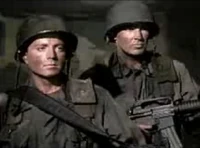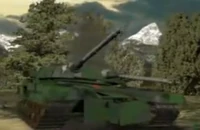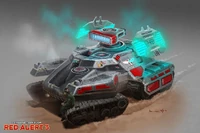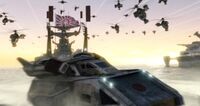Camouflage is, whether natural or manufactured, an adaptation to help lessen the ability to discern an object from its surrounding environment. This can mean anything from decreasing the chances of getting shot to blending in to a background outright. Also, camouflage can be as simple as the "olive drab" patterns uniforms of Rifle infantry from the Second World War to the high-tech disguise systems used by Mirage tanks.
History[]
Military camouflage did not enter standard military service until the 1900s. Prior to that, most armies adopted brightly colored uniforms for service, in order to make identification easier and foster unit cohesion. During the 1700s and 1800s, the poor accuracy of rifles and the tendency of armies to march in rows and columns largely eliminated the need for camouflage. Scouting units and militia would wear neutral tones, in order to make them harder to spot, but it wasn't until Western armies started to suffer enormous losses that they gave regular soldiers drab uniforms.
The First World War was the first major war where all the major participants began experimenting with camouflage. While the majority of the soldiers simply had duller, less noticeable uniforms, snipers and scouts developed specialized camouflage gear, including netting to mimic plant life.
Second World War[]
Allied use[]
During the Second World War, the various Allied nations generally issued their troops with solid-colour uniforms in various colours, including brown, field grey, and olive drab. They also experimented with camouflaged uniforms, although these were not widely issued. Allied combat vehicles, however, were often painted in camouflage patterns, although solid-colour paintjobs remained common throughout the war.
Allied forces also experimented with Gap Generator technology, which could obscure an area from outside viewers. This was most often used for concealing a base from enemy incursions. In addition, the first experiments in active camouflage were conducted, resulting in the Allied Phase Transport prototype. This vehicle was able to render itself invisible to the human eye by bending light around the vehicle.

Allied soldiers wearing late-war Olive Drab battledress uniforms, circa 1953.
| The following is based on the Soviet campaign of The Aftermath and might contradict canon. |
A Soviet cyborg named Volkov stole the Phase transport prototype, nullifying the chances of its serial production.
Soviet use[]

A knocked-out heavy tank with a forest camouflage paint-job
The Soviets also used camouflage. While their infantry were generally given standard olive uniforms and brown coats, their vehicles had several camouflage patterns designed for urban, forest, and desert environments. Interestingly, Soviet tanks were most often seen painted with black and grey urban camouflage, even in snowy environments.
Third World War (first and second iteration)[]
During the Third World War, Allied continued using gap generators to jam Soviet radar signals. Albert Einstein also developed the Mirage tank, which could take on the appearance of any organic item, mostly nearby trees, in order to disguise itself.
After the Allies travelled back in time to reboot the War, the gap generator was refitted so that it could "bend" Yuri's Psychic radar around itself to counter his unusual radar technology. However, the overwhelming telepathic power of a Psychic reveal was enough to temporarily overwhelm the generator's processors, revealing anything it hid for a few seconds.
Third World War (third iteration)[]

Allied Mirage Tank
Cherdenko's erasure of Albert Einstein meant that the Allies no longer had the gap generator technology to serve in their arsenal during the new Third World War. However, the latest version of the Mirage Tank had a secondary function named the gap generator that could hide all friendly units within its radius from the enemy. However, the Mirage tank itself was fully visible and unable to use its weapon, making it highly vulnerable. They were also unable to cloak each other using this secondary ability.

Sudden transport during the initial invasion of Russia.
The Imperial Sudden transport used a unique stealth camouflage system that allowed it to mimic the appearance of enemy vehicles. With this device, the Sudden Transport was able to slip through enemy lines and sneak its way past defenses, allowing it to deploy Imperial troops at enemies' vulnerable positions.
